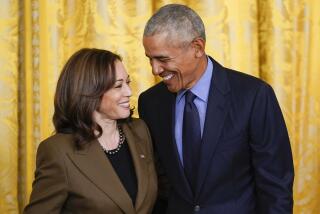
- Share via
WASHINGTON — In the end, Vice President Kamala Harris could not overcome a central contradiction: She was the “turn the page” candidate who served with Joe Biden, the oldest and one of the least popular presidents in history.
“I don’t think there necessarily was a path here for her. If you’re the vice president of an administration people want to fire, you’re way behind the eight ball to start,” said David Axelrod, former President Obama’s lead strategist.
Voters in the world’s Western democracies were bruised and angry after a life-changing pandemic, several years of price surges and a migration crisis. Many threw incumbent parties out, in some cases handing added power to previously fringe movements. Americans were no different. Three in four voters Tuesday prioritized the candidate “who could bring needed change,” according to exit polling.

“The previous four years, my eyes didn’t lie to me,” said CT Tilghman, a 50-year-old arborist from Reading, Pa. “We’re seriously off track with where we’re going and what we’re doing.”
President-elect Donald Trump, though he had been in office before and committed a host of previously disqualifying crimes and deeds, represented the ultimate change. He never followed a script, scoffed at the rules and spoke directly to the economic and cultural anxieties of the country in between grievances about his own perceived mistreatment.
The last time Donald Trump was president, California led the liberal resistance to his agenda. Now it is poised to reprise the role.
Harris, one of the most cautious and disciplined politicians in her party, defined herself in her stump speech as someone who would be “grounded in common sense and practical outcomes.” But in her interviews, she often appeared uncomfortable and unwilling to go off message, famously saying in a friendly interview on “The View” that she could not think of anything she would have done differently than Biden.
Even many of her supporters found that uninspiring. They often cited two reasons for their vote: her stance on abortion rights and a fear of Trump. Few had a strong sense of what she stood for beyond that.

“It’s not the best choice,” said Kevin Yanaga, a chef from West Philadelphia after voting for her on Tuesday. “But, you know, I don’t want to go to Trump, so that’s the only reason.”
Democrats were banking on the idea that that would be enough. They had a theory of the case. Trump had never broken above about 47% of the electorate. They didn’t need a transformative candidate, just someone who could persuade a broad anti-Trump coalition to show up to the polls.
“Voters don’t shift dramatically over a short period of time,” Cornell Belcher, Obama’s pollster, said recently.
This time, they did. Trump, as of Wednesday, appeared likely to win not only all of the swing states but also a majority of the popular vote, the first time for a Republican presidential candidate since 2004, when President George W. Bush defeated John F. Kerry, then a Massachusetts senator, in 2004.
The shift of voters without a college education toward Republicans, in motion for three or four decades, is no longer limited to white people. Trump’s share of Latino voters grew to 45%, compared with 32% four years ago, according to exit polls, which showed the biggest increase among men.

Many Democrats attribute part of Harris’ loss to sexism. Trump was able to exploit it in two elections, casting former Secretary of State Hillary Clinton in 2016 and Harris this year as weak.
“Whether it’s Hillary Clinton or Kamala Harris, regardless of what you say or do, you’re not going to appear as tough as a man who talks loudly,” said Joan Hoff, a presidential historian at Montana State University.
Democrats will be debating what went wrong for the next four years. But it starts with Biden’s decision to stay in the race after his party performed surprisingly well in the 2022 midterms. Many voters were noticing a decline as Biden, now 81, walked more stiffly and appeared to jumble his words. But Biden insisted he was the only one who could defeat Trump, who at 78 is now the oldest president ever elected. And few Democrats dared to challenge that self-assessment.
Trump, meanwhile, was solidifying support in the Republican Party and pounding the Biden administration’s handling of the economy and immigration, casting himself as a victim while pledging revenge against prosecutors and politicians who tried to hold him accountable. Biden was unable to mount a counterattack as Trump steamed over the Republican opposition.
By the time Biden held his disastrous debate with Trump in June, there was little time to find an alternative besides Harris, despite her obvious ties to his administration.

Harris, whose approval rating in polls was low to that point, overperformed expectations when she was elevated to the top of the ticket in late July, inspiring young voters who made joyful memes tied to her sometimes awkward speaking style. She impressed party insiders by solidifying the nomination and holding raucous rallies that reenergized base voters.
But she had little time to introduce herself to the public or outline an ambitious policy agenda. She felt she needed to show loyalty to Biden, preventing her from making a clean break with his policies.
“It should be such a simple proposition, but she didn’t do it,” said Sean Spicer, Trump’s former press secretary.
Donald Trump’s decisive presidential victory was confirmed after he picked up the battleground states of Georgia, North Carolina, Pennsylvania and Wisconsin.
Advisors said the timeline forced tough decisions. In three months, she had to explain who she was and what she stood for and win back Democrats who had lost enthusiasm for Biden.
“We have to understand the challenge she walked into,” said Karen Finney, a close Harris ally who worked as a senior advisor to Hillary Clinton’s 2016 campaign. “The fact that she had to come back from that far back.”
Trump was initially thrown off by the candidate switch but readjusted, returning to many of his 2016 themes that spoke more directly to the working class, said Faiz Shakir, a senior advisor to Vermont independent Sen. Bernie Sanders. He was hardly subtle, making appearances at McDonald’s that Democrats mocked as stunts. He made overtly sexist and racist appeals, continually attacking Harris as “low-IQ” and repeating lies about Haitian immigrants stealing pets so they could eat them.

But even as he veered into tangents and grievances, he continued to present himself as a threat to the establishment. Harris talked about her middle-class upbringing but had trouble conveying the pain being felt by the middle class, Shakir argued.
“He became the change agent and she became the creature of status quo,” Shakir said. “They were not competing on ideas. They were competing on the same idea that Joe Biden had, which is restore the soul of this nation.”
In the campaign’s final weeks, Harris went even harder in attacking Trump’s fitness for office. Her advisors had been increasingly frustrated that Trump’s rallies were no longer being televised and that polls showed his time in office was regarded better in 2024 than it was at the time. They emphasized warnings from many of his own closest advisors and top military brass that he was a would-be fascist who would be unencumbered if given another term.

Internal focus groups showed the argument was working, according to one person close to the campaign. But it was not enough to overcome more basic anxiety over the cost of living. Two in three voters said the nation’s economy is either not good or poor, according to exit polls.
Axelrod said Harris ran about as good a campaign as she could under the circumstances. But he said the Democratic Party has lost touch with the daily realities of many working-class voters as its support clusters around urban areas. Trump, even in his 2020 loss, won 84% of the nation’s counties.
“That should have been a warning sign that the Democratic Party has become big blue islands dotting a red map,” he said. “The people who live in those places don’t feel connected. They don’t feel like they’re being heard and, most of all, they don’t feel respected.”
Times staff writer James Rainey in Los Angeles contributed to this report.
More to Read
Get the L.A. Times Politics newsletter
Deeply reported insights into legislation, politics and policy from Sacramento, Washington and beyond. In your inbox three times per week.
You may occasionally receive promotional content from the Los Angeles Times.













